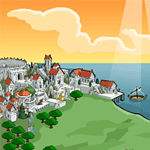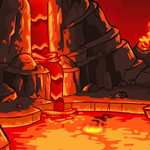 Architecture of Neopia: Altador
by arkwright
--------
To a scholar of Architecture, Altador is without a doubt the pre-eminent land in Neopia. The prevailing style is known as “classical”. For this reason, I ventured to the ancient land where the sultry evening streets are alive, with warming smells and crackling fires heating takeaway speciality hot dogs and fancy fig pastries. The architecture of this realm is often overlooked in favour of the annually held Altador Cup. Sports fanatics make up the most numerous tourist demographic, who amass and litter in their millions. Few come to appreciate the raw inspirational beauty the ancient buildings radiate, except as canvas for pasted posters advertising the games and the signups. By the time June comes to a close, the usual quiet lull swiftly returns to the city and the liveliest place one could encounter for most of the year becomes a sleepy library! For somebody who had only previously visited in June, it’s hard to believe the relative silence. It echoes down the long halls beneath tall arches for the remaining eleven months of the year.The geography and topography of the land is relatively simple. In fact if it weren't for the "Darkest Faerie Affair", Altador could easily have been the cultural and economic hub of all of Neopia. However its recent re-discovery (recent here is relative, within our lifetimes I should say) instantly returned into prominence. The land, attracting multitudes of people via the Altador Cup, its vast archives, and its glorious Hall of Heroes. Altador lies far down the South Western point of the largest Neopian continent. It stands south of Shenkuu and is separated from Neopia Central by a mountain range far more inhospitable than the Terror Mountain. It is a great walled city, similar architecturally to that of some Meridellian and Brightvalian fortified castles. Outside of Altador's walls one can find rolling countryside interspersed with lush farmland. There is a great port which also lies outside of the walls, and beyond that the sea. I am told that on a clear and bright day inhabitants can see the thin plumes of campfires from Lutari Island’s surrounding islets, and the occasional freight ship passing on the horizon line. Within the walls of Altador itself, the city is split into four main districts: the Arena District, the Park District, the Money District, and the Bazaar District by another great wall. The wall itself is not purely aesthetic or even remotely defensible, instead it is host to a large aqueduct and water processing plant. Whilst most cities process their water beneath ground, Altador is proud of its water security and puts it on display. With a large army, the walls have no need for defensibility, for the design fault with the aqueduct would make it incredibly easy for an attacking enemy to entirely flood the city. Furthermore, the octagonal nature of the walls makes the city even harder to defend from a siege, as this shape forces the defenders to guard a larger area than would otherwise be the norm. Looking closer at the four districts, each have their similarities and slight differences architecturally. To the West, we have the Arena District, home of the Colosseum and main attractions during the Altador Cup. This is often confused with being the North of Altador due to its frequent portrayal in maps as being at the "top". Here some of the Palladian enclosures are not only forae to gather and discuss (and scheme and plot in the darker moments of the Altador Cup), but also much of the Yooyuball athletes’ accommodation. It is this district which most people come for, and so it deserves special explanation. The Colosseum in particular, is the crowning-jewel of Altador- beautiful architecturally and a grand building built perfectly for purpose, with a capacity for tens of thousands of spectators each year. It, alike most of the structures in Altador is it built from stone, from the quarry just outside of Altador. It has three main floors, each with several tiers of seating, each surrounded by entrance and window arches, allowing for easy maneuverability and access. The very top-most tier’s arches are lined with statues of Ancient Heroes and, more recently, particular athletes of importance. This is vaguely done, with the idea of having inspirational figures watching over the games for good luck. Beneath the arena are an important network of underground tunnels and holding cells for various Yooyu balls. These tunnels also serve as an area for the players to wait and prepare for the coming match. The rapidity with which the games are played and the turnover of teams required to play each day is intense, and the Colosseum is built with this purpose in mind. The Southern District of Altador, the Money District above all shares the most common architectural features, as with the Arena District. The reason for this is that the concentration of wealth here is of a certain kind- a flashier and more exquisite kind. The kind which chooses to build its structures from marble with clay roof tiles and hold a reserved attitude, uniquely evident in the bricks and tiles, that the long shadowy corridors are silent and elite. This is the reason for the similar architecture. This is also the home of the Altadorian Archive. A building which has an exact but smaller replica within the Arena District. The replica in this case poses as a meeting place, with a remarkably different interior. The Archives itself are interesting architecturally, but plain. Typical of Altadorian architecture is the embellishment, column tops and great statues at every entrance, with a distinctly masculine order of column, not typically befitting of a glorified library. The most interesting architectural features of the archives are their vaulted archways. Arches in every doorway and domed ceilings in every entrance are a typical feature. Another aspect of interest is the lone building known as "Exquisite Ambrosia", whose architectural features would look far more in-place in the Bazaar District. The reason for this is the pale facade and purple roof with gold lining. At some point in the architectural history of Altador an architect decided that there would be two distinct styles signifying the different purposes of buildings- and this is how it has manifested itself. This is why, irregardless of purpose or whether the building should or 'should not' be present in the Money District, it is still an interesting aspect. The Eastern point of Altador is the Park District, complimenting the Arena District beautifully, especially during the Altador Cup where screams and cheers ring out for miles round. In contrast the Park District is instead a quiet haven. Entirely pointless save for an example of the lush greenery Altador is capable of, and the pure decadence of a city that it is able to donate a whole quarter to leisure. The only example of architecture found in the Park District- apart from its fine planning and layout, is the small cottage or two belonging to the park keepers and horticulturists who maintain the parks. There is a small restive area at the absolute far east which is of a similar classical order to the Altadorian Archive further south. It is a monument however and nothing more. Finally, the North of Altador is the Bazaar District. As previously mentioned, the architecture of the bazaar is incredibly unique compared to the rest of Altador, almost giving this area an impression of temporary fragility, as if the whole thing could be torn down any minute or packed up and moved elsewhere. The structures seem dainty in contrast to the solidity of buildings such as the colosseum. Most of the shops are situated at the top of their own individual hills, each a beacon of advertisement for their own individual products: petpets, armoury and magical concoctions. The tall arches and slender columns built from a darker and rougher stone contrast perfectly against the royal purple tiles. Purple is a difficult colour to come by naturally in most of Neopia not least of all Altador, which leads me to the conclusion that these shops are a recent addition to Altador, the tiles of which imported most likely from somewhere like Qasala or elsewhere. Furthering this theory, the gold plated lining of the alcoves and gutters is also a recent addition, though Altadorian clothing and armour is usually made from gold- it is a recent phenomena for gold to be architecturally fashionable. These four districts, unique and beautiful each are in their own way are mere reflections of the actual piece du resistance of Altador- something nobody can visit Altador without noticing and admiring. Like a great central palace standing watch over the regal city. The Hall of Heroes is without a doubt the best thing Altador has to offer, it is only fitting for a monument to some of the greatest in history to be splendid. The exterior of the building is unparalleled by any other I have seen so far in my travels in Neopia. It has a square base, and rises up typically Altadorian-ly octagonal to at least seven floors. I have lost count more times than I care to remember, wandering up the winding spiral staircase. Most of the building serves as spacr for administration under the King Altador kingship. I also believe, although I was not granted access to all of the Hall of Heroes building, that a lot of the lower floors also serve as his palace, a beautiful place for courtiers and learning, and the upper class of Altador. In order to reach the upper gallery displaying the infamous Altadorian statues one must navigate the beautiful open-plan palace-like first floor, up spiral staircases and tall fanes. Another important aspect of the Hall of Heroes upon which I can remark is contrasting to the tall arched domes, a tiled floor in a pearly bronze that glitters in the low light of the sun. Architecturally, the Hall of Heroes speaks wonders. Sitting on one of Altador’s many balconies with a view off towards the port, watching the sun slowly sink behind the calm waters... I cannot help but wonder whether the architecture of Altador is a spectacle because of its unique location and mystery to the city, or whether the architecture truly makes the city what it is. Nobody could deny its beauty, but the practicality of the entire layout is dubitable. Is this a tourist town? Dead for eleven months waiting for the seasonal games, or a true temple of education sullied by the sports fanatics?
| |
|
Search the Neopian Times
Great stories!
---------
 The Fire Within: Part Seven The Fire Within: Part Seven
“I intend to destroy Moltara City, the surface lands, even the space station and above. All the way to the top if I must. The purity of the core must be kept.”
by herdygerdy |
---------
---------
---------
 10 Bouquets For (almost) Every Occasion 10 Bouquets For (almost) Every Occasion
There are plenty of bouquets around Neopia and they can be suitable for occasions of all kinds. But with such a wide choice there are many Neopians who get stuck with the mind numbing fear that they may accidentally choose a bouquet inappropriate for the occasion. And if you do that then you know for sure you won't be receiving an invitation for the latest Neopian Ball. However this guide is here to help guide you to make the perfect bouquet choice for any occasion
by usukii |
|
|